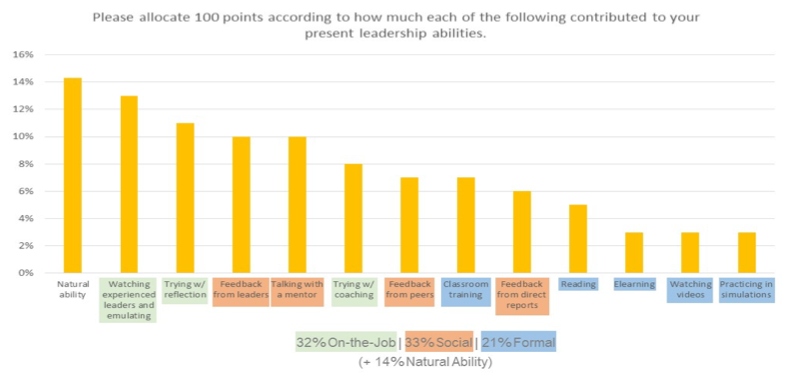How did you get where you are?
I asked this existential question to a talented, engaged group of five leaders during a routine training engagement. Survey data revealed they are in tune with a holistic view of development, one that goes beyond the classroom.
Learning professionals believe the answer is 70/20/10, the Center for Creative Leadership framework that has launched a thousand articles (+ 1!). Having recently completed a Designing, Delivering and Managing Modern Training for the Workplace workshop, I wanted to know how people who didn’t spend their days thinking about instructional design would characterize their own development.
Here’s the context: Leaders expressed a desire for change in a development program for their direct reports but struggled to articulate what changes to make. They advocated for classes or books they liked, most of which are just different flavors of the current formal solution set. Since people seldom argue with their own data, it was time to extract some.
One of the prompts in the survey was “Please allocate 100 points according to how much each of the following contributed to your present leadership abilities.” The items are shown below. Based on curiosity about fixed versus growth mindsets and the role of innate talent, I added a choice labeled natural ability.
The answers confirm that leaders arise from a rich set of experiences. More importantly, the answers show leaders know it takes more than a class or a book to grow as a professional.
Getting a room full of opinionated leaders to agree on an accurate rank prioritization of on-the-job, social and formal learning factors feels like a win. Though they started by recommending this class or that book to make their direct reports more effective, now they were testifying that the biggest improvement factors were reflection, conversations and feedback.
But why don’t the 32% on-the job, 33% social, 21% formal numbers match the classic 70:20:10 framework? One factor is the option to ascribe ability to innate talent. This siphons off 14% of the pool. The respondents may have correctly intuited that acquired characteristics are relevant to job performance. A second factor is how a person’s experience shapes their perception of outcomes: The respondents estimated, of their total development time, they had spent 36% learning on the job, 35% in activities that could be classified as social and 30% in formal learning. In other words, since the respondents spent roughly equally proportions of their development time in formal learning activities, perhaps they are more likely to evenly weight the activities. I suspect the quality of resources available to the leaders affected their weighting, too. For example, if a person had access to a skilled mentor, she would likely say mentoring played a more important role in her development than someone who had an unproductive mentoring relationship.
As an instructional designer, sometimes I have to stop myself from immediately jumping to information and classes when a training need is expressed. I can’t expect a different response from busy leaders with more important matters on their minds. In this instance, we restarted the conversation by asking for reflection before prescription. We’ll use the results of the survey to invigorate discussions as we evolve our leadership programs. After reflection, leaders know what matters – learning within work and meaningful conversations with colleagues, scaffolded on relevant learning experiences.
Latest posts by Eric Kammerer (see all)
- 32/32/21 (14) – How Managers Say They Developed Leadership Skills - 30 January 2018

